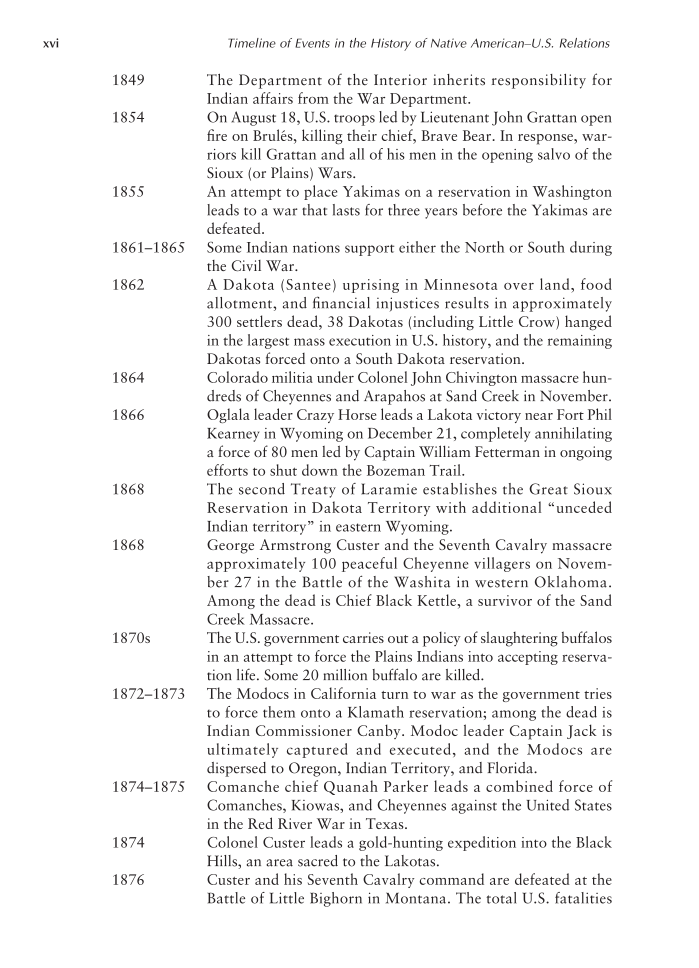1849 The Department of the Interior inherits responsibility for Indian affairs from the War Department. 1854 On August 18, U.S. troops led by Lieutenant John Grattan open fire on Brules, ´ killing their chief, Brave Bear. In response, war- riors kill Grattan and all of his men in the opening salvo of the Sioux (or Plains) Wars. 1855 An attempt to place Yakimas on a reservation in Washington leads to a war that lasts for three years before the Yakimas are defeated. 1861–1865 Some Indian nations support either the North or South during the Civil War. 1862 A Dakota (Santee) uprising in Minnesota over land, food allotment, and financial injustices results in approximately 300 settlers dead, 38 Dakotas (including Little Crow) hanged in the largest mass execution in U.S. history, and the remaining Dakotas forced onto a South Dakota reservation. 1864 Colorado militia under Colonel John Chivington massacre hun- dreds of Cheyennes and Arapahos at Sand Creek in November. 1866 Oglala leader Crazy Horse leads a Lakota victory near Fort Phil Kearney in Wyoming on December 21, completely annihilating a force of 80 men led by Captain William Fetterman in ongoing efforts to shut down the Bozeman Trail. 1868 The second Treaty of Laramie establishes the Great Sioux Reservation in Dakota Territory with additional “unceded Indian territory” in eastern Wyoming. 1868 George Armstrong Custer and the Seventh Cavalry massacre approximately 100 peaceful Cheyenne villagers on Novem- ber 27 in the Battle of the Washita in western Oklahoma. Among the dead is Chief Black Kettle, a survivor of the Sand Creek Massacre. 1870s The U.S. government carries out a policy of slaughtering buffalos in an attempt to force the Plains Indians into accepting reserva- tion life. Some 20 million buffalo are killed. 1872–1873 The Modocs in California turn to war as the government tries to force them onto a Klamath reservation among the dead is Indian Commissioner Canby. Modoc leader Captain Jack is ultimately captured and executed, and the Modocs are dispersed to Oregon, Indian Territory, and Florida. 1874–1875 Comanche chief Quanah Parker leads a combined force of Comanches, Kiowas, and Cheyennes against the United States in the Red River War in Texas. 1874 Colonel Custer leads a gold-hunting expedition into the Black Hills, an area sacred to the Lakotas. 1876 Custer and his Seventh Cavalry command are defeated at the Battle of Little Bighorn in Montana. The total U.S. fatalities xvi Timeline of Events in the History of Native American–U.S. Relations
Document Details My Account Print multiple pages
Print
You have printed 0 times in the last 24 hours.
Your print count will reset on at .
You may print 0 more time(s) before then.
You may print a maximum of 0 pages at a time.










































































































































































































































































































































































